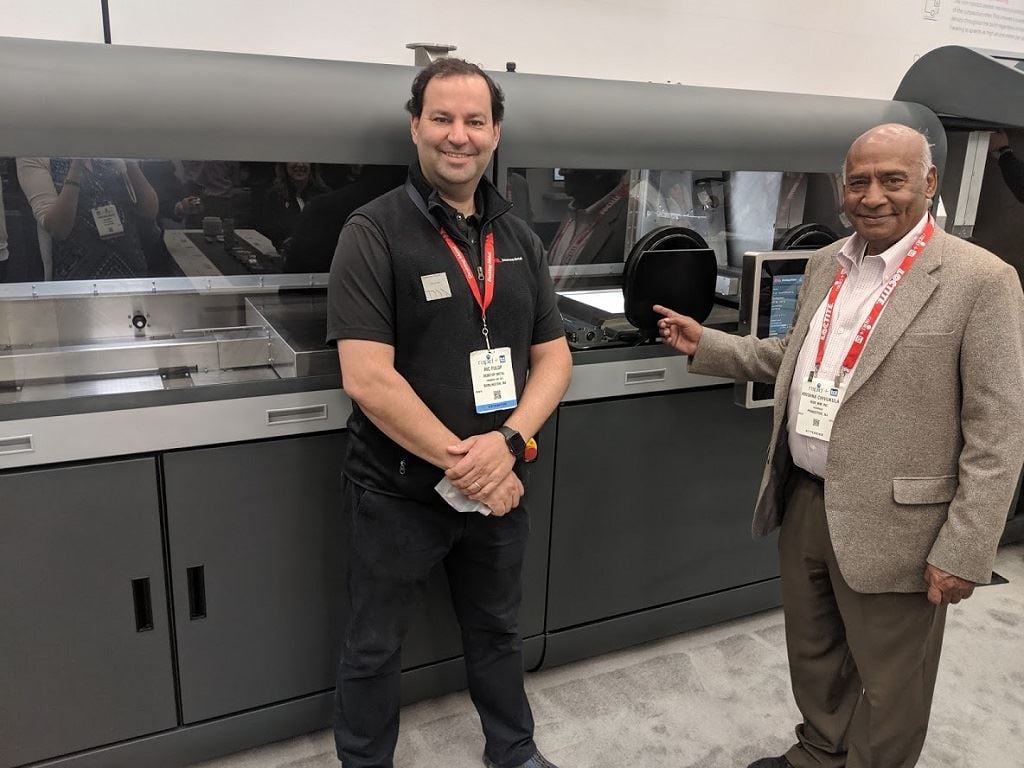![Ric Fulop (left), Dr. Krishna Chivukula, and a Production System [Image: Fabbaloo]](https://fabbaloo.com/wp-content/uploads/2020/05/DMIndo-MIMPSa_img_5eb096b73fe85.jpg)
We talked with executives from Desktop Metal and new partner Indo-MIM to dig deeper into metal on demand.
The companies announced a strategic partnership last week, bringing together operations of the dynamic metal 3D printing company and the world’s largest metal injection molding (MIM) supplier. The move is a big one, marrying metal capabilities in additive manufacturing together with traditional manufacturing.
As I caught up with Desktop Metal Co-Founder and CEO Ric Fulop, Indo-MIM Founder and Chairman Dr. Krishna Chivukula joined us for a brief chat to illuminate more of the story from the MIM side of operations.
Indo-MIM is set to install a Desktop Metal Production System at its San Antonio facility. The company, Chivukula noted, is involved mostly in MIM, but also has interest in other metal technologies.
“Our focus is MIM; in that field we are the biggest,” Chivukula noted. “Number two is probably one-quarter our size. It’s very exciting to partner with Desktop Metal, it’s the new way. This makes it very interesting for us in metal and as businessmen. Desktop Metal is advancing the technology to the next level.”
The benefits for Desktop Metal lie in working closely with a segment many see more as the competition. Production-scale metal 3D printing is intended to compete with metal injection molding — but, as with many things in life, working together might be a better way ahead for everyone.
“Indo-MIM has some of the most sophisticated competence in sintering,” Fulop said. “Their parts are in every major automotive OEM.”
Indo-MIM is indeed active across a variety of industries and applications. Chivukula ticked off uses in robotics, medical, hand tools, aerospace: “You name it.”
“This will take MIM to the next level in applications. We will make larger parts, more complex parts, all designed to suit,” Chivukula continued. “We can help customers to reduce weight, to put weight only where it is needed.”
![Ric and Krishna smile in the crowded Desktop Metal booth [Image: Fabbaloo]](https://fabbaloo.com/wp-content/uploads/2020/05/DMIndo-MIMa_img_5eb096b7b4a4c.jpg)
Indo-MIM has plants in India and in Texas. The San Antonio Production System installation will be the first for the company, as it offers the Desktop Metal technology alongside its other, more conventional metal options for customers.
“This is disruptive technology to MIM,” Chivukula acknowledged. “Disruption is inevitable. It is part of life, and the best way to handle it is to disrupt yourself, to sit in the driver’s seat and drive your life, to manage the process of disruption.”
This mindset, he concluded, will help to “grow markets more manageably.”
Managing growth, managing disruption, is a major focus now for industry in general as the technologies of Industry 4.0 are being realized.
As this particular relationship shows, though, one of the best relationships for traditional and additive manufacturing is side by side. Each process offers specific advantages and is limited by certain disadvantages, and together they can potentially offer the best of both worlds.
Along with the Indo-MIM partnership, Desktop Metal highlighted last week at RAPID + TCT that it is shipping its Production Systems, has officially released its Fab Flow software, and has introduced Live Parts 2.0.
Via Desktop Metal

